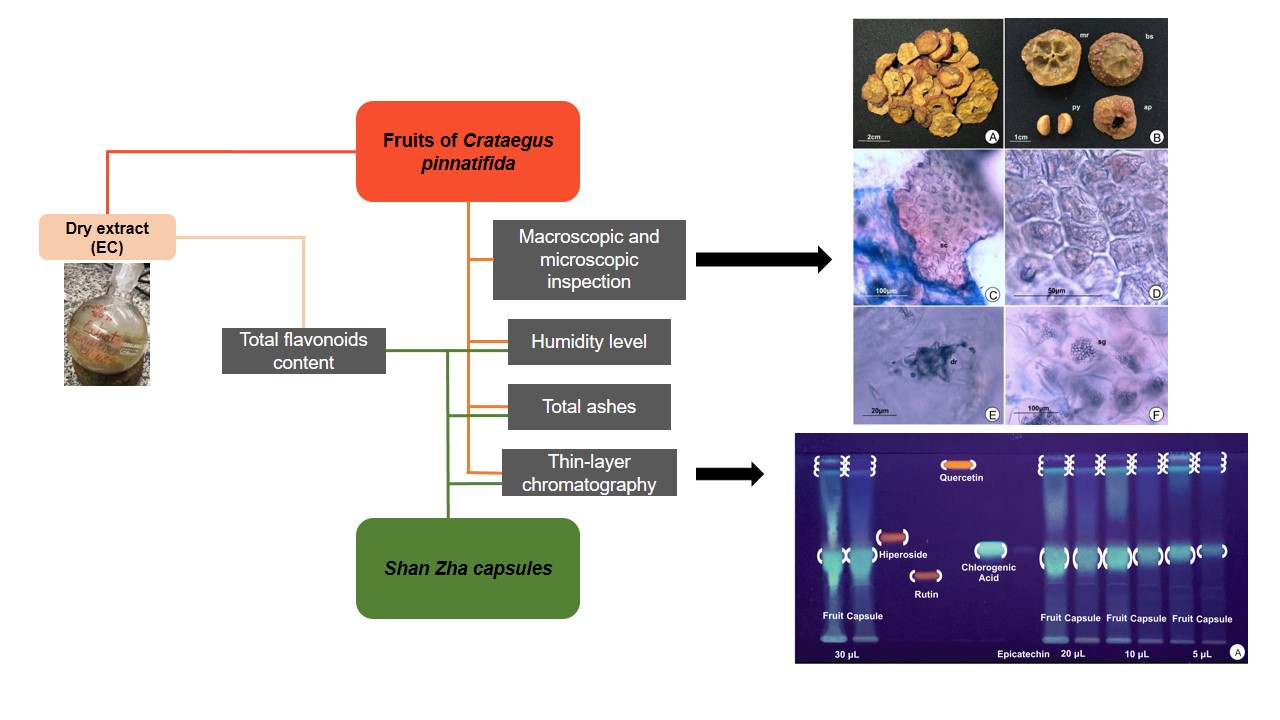Do Crataegus pinnatifida capsules sold in Brazil undergo pharmaceutical quality control? Is there a quality control adopted in Brazil?
DOI:
https://doi.org/10.70151/mr1m1c57Keywords:
Thin layer chromatography, phytopharmaceutical products, total phenolic contentAbstract
The Chinese hawthorn, Crataegus pinnatifida, Rosaceae, is widely used in Traditional Chinese Medicine (TCM). As there is no Brazilian legislation to carry out the quality evaluation of this drug, this work aimed to carry out the quality control of C. pinnatifida capsules (Shan Zha), sold commercially in Brazil. Due to lack of reference standard, an extract of the C. pinnatifida fruits (EC) was prepared. The quality control of the fruits presented adequate botanical analysis of the fruits and presented macroscopic characteristics in accordance with Chinese Pharmacopoeia. For the fruits, the sample had no foreign matter and the total ash content was 0.724 ± 0.160%. The capsules showed adequate dose uniformity, moisture content of 14.75 ± 0.476%, total ash content of 1.51 ± 0.199%. The total flavonoid (TF) percentage was 0.012% for the dried extract of fruits and 0.005% for the Shan Zha capsules. This study highlights the importance of carrying out quality control to ensure the authenticity and quality of products that fall within the classification of supplements in Brazilian legislation and guide the dose calculation for C. pinnatifida products.
Downloads
References
Brasil. National Health Surveillance Agency – ANVISA (2010) Farmacopeia Brasileira 5º edição. Calendula officinalis monograph. https://www.gov.br/anvisa/pt-br/assuntos/farmacopeia/farmacopeia-brasileira/5a-edicao-volume-2
Brasil. National Health Surveillance Agency – ANVISA (2014) Resolution of the Collegiate Board – RDC - number 21 of April 25. https://bvsms.saude.gov.br/bvs/saudelegis/anvisa/2014/rdc0021_25_04_2014.pdf
Brasil. National Health Surveillance Agency – ANVISA (2017) Resolution of the Collegiate Board – RDC - No 166 of July24. https://www.in.gov.br/materia/-/asset_publisher/Kujrw0TZC2Mb/content/id/19194581/do1-2017-07-25-resolucao-rdc-n-166-de-24-de-julho-de-2017-19194412
Brasil. National Health Surveillance Agency – ANVISA (2019) Farmacopeia Brasileira 6º edição. Calendula officinalis monograph. https://www.gov.br/anvisa/pt-br/assuntos/farmacopeia/farmacopeia-brasileira/6a-edicao-volume-2
Brasil. National Health Surveillance Agency – ANVISA (2019) Resolution of the Collegiate Board – RDC - No 301 of August 21. https://www.in.gov.br/en/web/dou/-/resolucao-rdc-n-301-de-21-de-agosto-de-2019-211914064
Brasil. National Health Surveillance Agency – ANVISA (2020) Manufacture and commercialization of Traditional Chinese Medicine (TCM) products. http://www.cvs.saude.sp.gov.br/up/faq_mtc_versao-2.pdf
Chang Q, Zuo Z, Chow MSS, Ho WKK (2006) Effect of storage temperature on phenolics stability in hawthorn (Crataegus pinnatifida var. major) fruits and a hawthorn drink. Food Chem 98(3):426–430. https://doi.org/10.1016/j.foodchem.2005.06.015
China. Pharmacopoeia of the peoples republic of China (2015) China Medical Science Press, Heathorn monography.
Dai H, Zhang Z, Guo X (2007) Adventitious bud regeneration from leaf and cotyledon explants of Chinese hawthorn (Crataegus pinnatifida Bge. var. major N.E.Br.). In Vitro Cell and Dev Biol - Plant 43(1):2–8. https://doi.10.1007/s11627-006-9008-3
Degenring FH, Suter A, Weber M, Saller R (2003) A randomised double blind placebo controlled clinical trialof a standardised extract of fresh Crataegus berries (Crataegisan®) in the treatment of patients with congestive heart failure NYHA II. Phytomed 10(5):363–369. https://doi.10.1078/0944-7113-00312
Dehghani S, Mehri S, Hosseinzadeh H (2019) The effects of Crataegus pinnatifida (Chinese hawthorn) on metabolic syndrome: A review. Iranian J Basic Med Sci 22(5):460-468. https://doi.10.22038/IJBMS.2019.31964.7678
Eisenberg DM, Davis RB, Ettner SL, Appel S, Wilkey S, Rompay MV, Kessler RC (1998) Trends in alternative medicine use in the United States, 1990-1997: results of a follow-up national survey. JAMA 280(18):1569-75. https://doi.10.1001/jama.280.18.1569
European Directorate for the Quality of Medicines. European Pharmacopoeia (2019). 10th ed. European Directorate for the Quality of Medicines; Strasbourg, France.
Farias MR (2004) Avaliação da Qualidade de Matérias-primas Vegetais. In: Simões CMO (Ed.). Farmacognosia da Planta ao Medicamento Porto Alegre: Editora da UFRGS, 2004. p. 263-88.
Gallo L, Rigo-Ramírez MV, Pina J, Bucalá V (2015) A comparative study of spray-dried medicinal plant aqueous extracts. Drying performance and product quality. Chem Engineer Res Des 104:681–694. https://doi.org/10.1016/j.cherd.2015.10.009
Jurikova T, Sochor J, Rop O, Mlcek J, Balla S, Szekeres L, Adam V, Kizek R (2012) Polyphenolic profile and biological activity of chinese hawthorn (Crataegus pinnatifida BUNGE) fruits. Molecules 17(12):14490-509. https://doi.10.3390/molecules171214490
Kao ES, Wang CJ, Lin WL, Yin YF, Wang CP, Tseng TH (2005) Anti-inflammatory potential of flavonoid contents from dried fruit of Crataegus pinnatifida in vitro and in vivo. J Agricul Food Chem 53(2):430–436. https://doi.10.1021/jf040231f
Kumar D, Arya V, Bhat ZA, Khan NA, Prasad DN (2012) The genus Crataegus: chemical and pharmacological perspectives. Braz J Pharmacog 22(5):1187–1200. https://doi.org/10.1590/S0102-695X2012005000094
Lin A, Chan G, Hu Y, Ouyang D, Ung COL, Shi L, Hu H (2018) Internationalization of traditional Chinese medicine: Current international market, internationalization challenges and prospective suggestions. Chinese Med 9:13-19. https://doi.10.1186/s13020-018-0167-z
Liu P, Yang B, Kallio H (2010) Characterization of phenolic compounds in Chinese hawthorn (Crataegus pinnatifida Bge. var. major) fruit by high performance liquid chromatography-electrospray ionization mass spectrometry. Food Chem 121(4):1188–1197. https://doi.org/10.1016/j.foodchem.2010.02.002
Morais LAS (2009) Influência dos fatores abióticos na composição química dos óleos essenciais. In: Embrapa Meio Ambiente. Artigo em anais de congresso (ALICE). Horticultura Brasileira, Brasília, DF 27(2):S3299-S3302. http://www.alice.cnptia.embrapa.br/alice/handle/doc/57768
Rigelsky JM, Sweet BV (2002) Hawthorn: Pharmacology and therapeutic uses. Am J Health Syst Pharm 59:417–422. https://doi.10.1093/ajhp/59.5.417
Rocha T, Amaral JS, Oliveira MBPP (2016) Adulteration of dietary supplements by the illegal addition of synthetic drugs: A review. Comp Rev Food Sci Food Safety 15(1):43–62. https://doi.org/10.1111/1541-4337.12173
Rohrer JR, Robertson KR, Phipps JB (1991) Variation in structure among fruits of Maloideae (Rosaceae). Am J Botany 78(12):1617–1635. https://doi.org/10.2307/2444843
Shakyra AK (2016) Medicinal plants: Future source of new drugs. Int J Herb Med 4(4):59–64. https://doi.10.13140/RG.2.1.1395.6085
Wang J, Wong Y, Liao F. What has traditional Chinese medicine delivered for modern medicine? (2018) Expert Rev Molec Med 20:1-9. http://doi.org/10.1017/erm.2018.3
Wu J, Peng W, Qine R, Zhou H (2014) Crataegus pinnatifida: chemical constituents, pharmacology, and potential applications. Molecules 19(2):1685-712. https://doi.10.3390/molecules19021685.
Yang N, Chen H, Jin Z, Hou J, Zhang Y, Han H, Shen Y, Guo S (2020) Moisture sorption and desorption properties of gelatin, HPMC and pullulan hard capsules. Int J Biol Macromol 15(159):659–666. https://doi.10.1016/j.ijbiomac.2020.05.110.

Downloads
Published
Issue
Section
License

This work is licensed under a Creative Commons Attribution-NonCommercial-NoDerivatives 4.0 International License.

